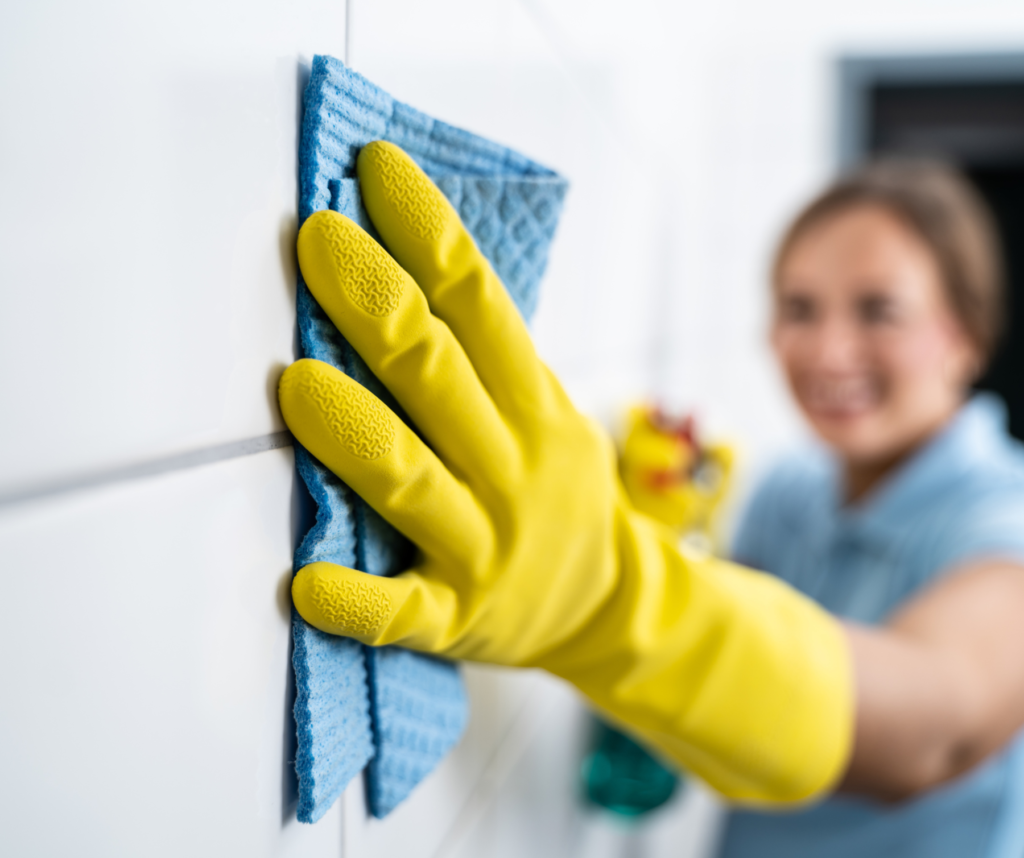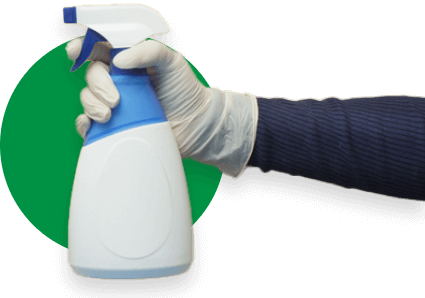When a construction project is complete, the final step is thoroughly inspecting the job site to ensure everything is clean, organized, safe, and put away. This final walkthrough usually involves a construction punch list and ensures that all loose ends are tied up, damages are addressed, and the property is up to standard. One way to ensure all of these are done is by creating and utilizing a custom post-construction cleaning checklist.
Checklists are essential for our readers to ensure their projects meet the necessary standards. You can streamline the process and achieve outstanding results by learning efficient and quality post-construction cleanup techniques with the checklist provided in this article.
What is A Post-Construction Cleaning Checklist
A post-construction cleaning checklist is a detailed document that breaks down a worksite’s different areas into specific cleaning categories. It helps workers walk through each space and identify any cleanup tasks needed before the project can be considered complete.
Post-construction cleaning requires precision. It’s important to clean every nook and cranny of the space to ensure it’s safe and ready for use. Use the right tools for the job, including microfiber cloths, vacuum cleaners, and mop heads. Avoid harsh chemicals, which can damage surfaces or cause health hazards. Instead, use water, vinegar, and baking soda for a safe and effective cleaning solution.
Your post-construction cleaning checklist should cover each area of the building. It should serve as a guide to help workers inspect all aspects of the building—from floors, windows, and ceilings to external features and removing trash and debris.
A Cleaning Expert’s Ten-Step Post-Construction Checklist
Thorough post-construction cleaning is crucial for ensuring occupants’ safe and healthy environment. Post-construction checklists include necessary cleaning tasks that help provide a comprehensive cleanup at the construction site. Here are the essential tasks to include:
Prepare Cleaning Supplies and Equipment
Before you start cleaning, make a list of all the different tools and cleaning supplies you might need. Collecting your supplies before you clean will ensure you can get right to work and not lose the “flow” of cleaning by having to run to the store for a cleaner or tool. Here’s a sample list of some common cleaning tools and supplies you may need:
- Brooms and dustpans
- Mops and buckets
- Vacuum cleaners (preferably with HEPA filters)
- Microfiber cloths and sponges
- Scrub brushes
- All-purpose cleaners
- Glass cleaners
- Disinfectants
- Rubber gloves and dust masks
Remove Dust and Large Debris from Construction Site
Begin by removing large debris, leftover construction materials, and any waste inside the building and exterior ground that will obstruct the cleaning job. This may include:
- Drywall pieces and wood scraps
- Packaging materials and plastic sheeting
- Nails, screws, and other fasteners
- Broken tiles or glass
- Unused adhesives and sealants
Dispose of these materials properly, following local regulations for construction waste.
Initiate Cleaning by Dusting Ceilings and Walls
- Dust and vacuum all surfaces, including floors, walls, ceilings, windows, and furniture. Use a vacuum with a HEPA filter to capture all dust particles for best results.
- Large amounts of dust accumulate on ceiling fans, so pay special attention to this area.
- Use a soft-bristled brush or vacuum cleaner attachment to remove dust or debris from walls.
- Wipe down barriers with a damp cloth or sponge to remove any remaining dirt.
- Use a mild detergent to clean any stains or marks on painted walls.
- Sweep or vacuum up any debris from floors, then mop with a mild detergent solution.

Clean Residual Dust from Doors and Windows
- Wipe down all surfaces with a disinfecting cleaner. This includes countertops, windows, walls, and other surfaces.
- Clean windowsills, as they are an area where a lot of dust and debris can accumulate. Dust these and wipe them down to properly remove all debris.
- Clean ceilings, walls, door frames, flat surfaces, and light fixtures to remove dust and construction particles.
- Wash interior and exterior windows to remove smudges, dust, and construction residues.
- Clean and dust the tops and sides of doors. When a door is appropriately cleaned and dusted, it can look beautiful and help improve the room’s overall look.
Clean Glass, Windows, and Mirrors
- Clean the windows with a product such as Windex and a paper towel, or use organic window cleaning products if you prefer natural options. Clean the windows until no handprints or streaks are visible.
- Wipe the mirrors to eliminate any streaks or dirty spots. If a mirror is dirty, it gets noticed very quickly because people look in them frequently.
Remove Paint Stains and Spills
- If paint has dripped onto floors or walls, use a scraper or putty knife to remove it. For dried-on paint, use a paint remover solution or rubbing alcohol. Be sure to test any chemical solutions on a small, inconspicuous area first to ensure they won’t damage the surface.
- Check for paint on hinges, which can happen if the painter accidentally touches the paintbrush during the painting process.
Clean Cabinets, Shelves, Drawers and Hard-to-Reach Corners
- When cleaning the kitchen, take the time to wipe down the cabinets and remove any stains or debris that might have accumulated on them. Cabinets help add beauty to kitchens, so clean them thoroughly to make your kitchen look great.
- Moldings and cabinets are another favorite resting spot for dust particles. Take a duster to these areas next.
- Clean the interior shelves of all cabinets, paying special attention to those hard-to-reach corners.
- Wipe off countertops and any other flat surfaces before tackling the dirt and debris that’s on or near the floor. Then, sweep out any visible dust and mop your hard floors from wall to wall.
Clear Away Extra Caulk
If any stubborn remnants of caulk are left behind, you can use a solvent to dissolve them. Apply a small amount of solvent, such as rubbing alcohol or mineral spirits, to a clean cloth and gently rub it over the remaining caulk residue. This should help to loosen it and make it easier to wipe away.
Vacuum Construction Dust from Vents, Air Ducts, and HVAC Systems
- Dust vents, air ducts, HVAC systems, and grates to ensure they are free from debris and dust particles, which can affect air quality.
- There’s a good chance that the HVAC system and subsequent air ducts are coated in dust from drywall, woodwork, etc., especially if the AC system was running during construction. If you leave this dust behind, every time the AC turns on, it’ll pour more dirt into the space and create unhealthy, low-quality air.
- Air filters should be replaced after ducts and vents are cleaned.
- You probably don’t think much about cleaning your grates or vents, but these areas should not be neglected. Dust and grime can easily gather there; if the vents aren’t clean, that dust will be blown around the entire home or office.
Floor Cleaning
- If hard floors are in your space, they must be mopped. This extra step ensures all dirt and debris from the construction crew is picked up, leaving your space tidy and clean.
- Floors are the last area to clean; otherwise, they’ll continue attracting more dirt as you dust walls, countertops, etc.
- New and old flooring tends to get a lot of wear and tear during construction, which means deep cleaning is essential. Carpets may need steam cleaning, while tile floors may need to be stripped and waxed.
- Sweep and mop hard floors to remove dust and construction residues.
- Vacuum carpets and rugs thoroughly to eliminate any embedded dirt and dust.
- Clean baseboards and corners, where dust tends to accumulate.
Clean Light Fixtures, Blinds, and Shutters
- Polish fixtures and fittings to enhance their shine and appearance.
- Check for any leftover paint or adhesive residues and remove them.

Essential Items for Your Cleaning Checklist in Key Areas
Various parts of a construction project need different cleaning approaches. If your construction site includes the areas listed below, you may want to add more items to your cleaning checklist.
Bedroom Area
If the construction work takes place indoors, chances are that the whole space will end up dusty (even if you can’t see it at first!)
For bedrooms and living spaces, your checklist should include:
- Vacuum and damp-mop floor surfaces to remove debris and residue
- Steam clean carpets and rugs to remove dirt and stains
- Dust and wipe light switches
- Dust and wipe windows and windowsills
- Dust and wipe tables, shelves, and other flat surfaces
- Wipe and polish knobs, handles, switches, and other small elements
- Clean baseboards and walls of marks and stains
- Clean mirrors (if any)
- Clean and dust closets and shelves
- Take out the trash
Kitchen Area
Kitchens in commercial and private properties demand a careful, meticulous approach to post-construction cleanup due to the high sanitary standards they must meet.
For kitchens, your checklist should include:
- Remove marks or paint stains from walls and baseboards
- Deep-clean and disinfect all surfaces where food is handled
- Clean the sink and the stovetop using a degreaser
- Vacuum and mop the floor
- Clean cabinets and drawers inside and outside
- Clean kitchen appliances, including ovens, stoves, refrigerators, and microwaves
- Clean windows and glass surfaces
- Clean doors, including doorknobs and door frames
- Clean light fixtures
- Polish stainless steel surfaces
- Clean and disinfect exhaust fans, filters, and ventilation grills
- Remove all trash
Bathrooms
While bathrooms tend to be among the smallest areas on a property, be prepared to spend a significant amount of time and resources to make sure you leave these areas clean and sanitized for use.
For bathrooms, your checklist should include:
- Clean and disinfect toilets
- Clean and sanitize sinks and faucets
- Scrub and disinfect bathtubs
- Clean and disinfect showers
- Clean tiles with a non-abrasive cleaning material
- Wipe and polish mirrors and other reflective surfaces
- Take out the trash and sanitize the trash container
- Vacuum, mop, and sanitize the floor
- Wipe and sanitize the walls
- Clean cabinets inside and outside
- Dust and wipe baseboards
- Clean light switches
- Remove construction stickers or protective coverings from bathroom fixtures
- Clean bathroom accessories, such as toilet paper holders and towel racks
High-Traffic Areas
High-traffic areas include entrances and exits, corridors, lobbies, and other spaces where a large number of people pass through or gather.
In many cases—particularly when it comes to commercial properties—these high-traffic areas also have significant presentation value. For instance, the lobby of a large company’s headquarters can make or break a potential customer’s first impression of the company.
High-traffic areas are also more susceptible to wear and tear, which can be partially slowed by good upkeep.
For high-traffic areas, your checklist should include:
- Remove construction and demolition materials, such as drywall pieces, wood scraps, and packaging materials
- Clear out dust and debris from vents and ducts
- If there is hazardous waste, dispose of it in accordance with local regulations
- Clean glass and reflective surfaces
- Clean and test lights and switches
- Dust and wipe entrance doors and doorknobs
Exterior Areas
Don’t forget to clean the exterior to create a welcoming atmosphere from the moment your customers approach the house or building.
For exterior areas, your checklist should include:
- Sweep and/or power wash walkways
- Pick up trash and debris
- Remove unused construction materials and equipment
- Sweep decks, porches, and patios
- Clean garage doors or parking barriers
- Make sure that the landscaping design elements and décor are returned to their original positions
A comprehensive post-construction cleaning checklist can help you make sure that all areas are inspected, sanitized, and ready for use.

The Benefit of Hiring Post-Construction Cleaning Services
Completing every task on the cleaning checklist can be difficult, as the cleanup process can take considerable time. This is where hiring a professional post-construction cleaning company like Dallas Janitorial Services can be beneficial.
Here are some key advantages of employing professionals for post-construction cleaning:
- Expertise and efficiency: Professional cleaners have the knowledge, skills, and equipment to clean thoroughly and efficiently, saving you time and effort.
- Attention to detail: Experienced cleaning teams follow comprehensive checklists to ensure no area is overlooked, resulting in a spotless, move-in-ready space.
- Health and safety: Professional cleaners use eco-friendly, industry-approved cleaning products and follow proper safety protocols to protect the health of occupants and the environment.
- Customized solutions: Reputable cleaning companies tailor their services to your specific needs, whether you require a one-time deep clean or ongoing maintenance.
Leave the Checklist to the Post-Construction Cleaning Experts
Understanding what post-construction cleaning includes is important, but executing every item on the checklist requires expertise and specialized equipment. Dallas Janitorial Services has mastered the art of post-construction cleanup, ensuring no detail is overlooked. Why stress about managing an extensive cleaning checklist when our experienced team can handle it all? From debris removal to final touches, we guarantee a thorough clean that meets all industry standards.
Contact Dallas Janitorial Services today for a free consultation and let our experts transform your newly constructed space into a pristine, move-in-ready environment. Experience the difference that professional post-construction cleaning can make!
FAQs About Post-Construction Cleaning Checklist
What is the correct order of steps for post-construction cleaning?
Post-construction cleaning typically involves three phases: rough, light, and final. Each stage has its focus, level of intensity, and tasks that need to be done for a complete cleanup.
How to clean up after builders?
Post-construction cleaning steps include:
- Remove any remaining construction debris.
- Tackle stains and spots such as paint and caulking splashes and adhesive residue.
- Wipe down windows, glass doors, and partitions.
- Remove any stickers on glass or appliances.
- Wash down walls, door frames, and baseboards.
- Sweep and vacuum floors.
What are the 5 stages of cleaning?
The 5 stages of cleaning are:
- Preparation – preparing mentally and physically for the cleaning process
- Dusting – removing dust and cobwebs from surfaces
- Cleaning – using cleaning products to remove dirt and grime
- Sanitizing – using disinfectants to kill germs and bacteria
- Final touches – adding finishing touches like straightening items or replacing supplies
How do you clean concrete after construction?
Use a clean, damp mop with warm water and mild detergent for large concrete areas. Use tools like a broom with stiff bristles or a wet sponge mop for surfaces that need gentle care.







